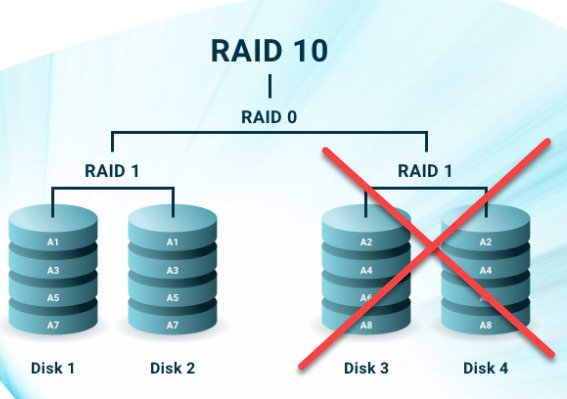RAID 10, losing TWO drives, did I actually LOSE DATA?
ASKER
ah, ok, thanks!
We've BTDT so have not deployed RAID 10 since.
Replaced a bad drive, rebuild started, about 5 minutes into our coffee while the rebuild was running the server spontaneously rebooted to a blinking prompt. :-(
We had to recover everything from backup.
We've BTDT so have not deployed RAID 10 since.Well, the key is not only the RAID level, but also the number of disks used.
E,g, a RAID10 with 8 disks (4/4) means that you can lose 3 disks and be guaranteed operational. And it means, when you're lucky, you can lose 6 disks and still have a working RAID10 (probability should be 33%).
The most common error with RAID in general and RAID10 especially is indeed using too few disks. And not realizing the difference about guaranteed operational and luckily operational.
When it comes to spinning rust (HDDs) the most stressful time on a disk is during rebuld.
Since RAID 10 is a mirrored pair striped across many pairs, if one of those mirrored pairs dies then its partner will be stressed during the rebuild. That's what got us.
So, if the first death is because of a weakness in the make/model/firmware level then there's a greater probability that its mate will die during the rebuild.
RAID 6 for spinning rust or Storage Spaces.
In the small form factor space (2.5") there's no reason not to deploy Enterprise grade SATA SSDs over spindles anymore. IMNSHO of course.
When it comes to spinning rust (HDDs) the most stressful time on a disk is during rebuld.Not only the disks. It had it once, that a secondary controller was killed during the rebuild (overheated due to dust).
Since RAID 10 is a mirrored pair striped across many pairs [..]That's what I tried to point out. RAID10 is a stripe set over an arbitrary number of RAID1, with a constant number of disks per RAID1. And strictly speaking, over different controllers for the RAID0 and each RAID1.
In the small form factor space (2.5") there's no reason not to deploy Enterprise grade SATA SSDs over spindles anymore. IMNSHO of course.Requires either also a RAID or a larger RTO.
But to be honest, I never understood the most use-case of people for RAID10. RAID5/6, RAID0 or RAID1 where the ones which made sense.
In the end, the OP got an answer. The rest is nitpicking.

Raid 10 can only withstand a single drive failure.